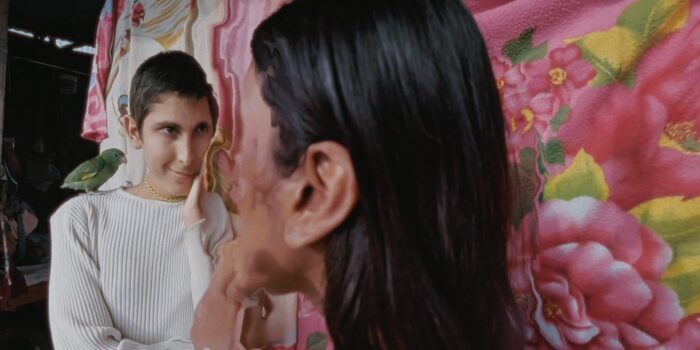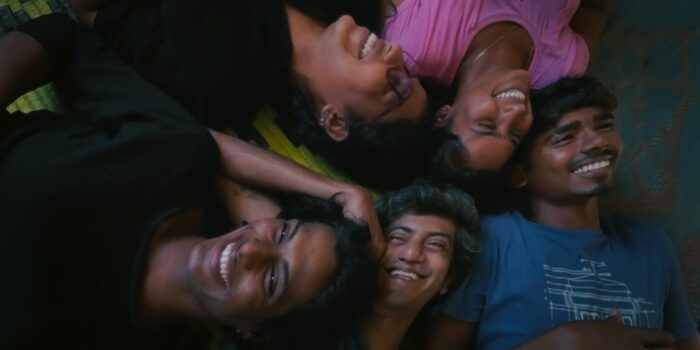Decolonial Odyssey
On Eduardo Williams’ “The Human Surge 3”
The film The Human Surge 3 explores the young generation’s climate anxieties through an overstimulating technique fit for the digital age. An experimental and decolonial odyssey that bends the world with a 360-degree camera, the film slips between Sri Lanka, Taiwan and Peru, blurring them into one gloomy jungle where murmurs of Tamil, Mandarin Chinese and Spanish overlap, melting with eerie ambient sounds.
The Human Surge 3 film screening and Q&A with director Eduardo Williams (March 6th, 6pm at Cinema Spazio Scena, Rome) is part of the program Decolonize! Digital Delights and Disturbances 2024, organized by John Cabot University’s Communications and Media Studies Department.
Digital Delights & Disturbances (DDD) offers radical ways to think out-of-the-(digital)-box we live in, imaginative and informed food for thought to feed our souls lost in the digital mayhem. The Spring 2024 edition, dubbed “Decolonize! Digital Delights & Disturbances,” features a journey through technology with a decolonial and anticolonial gaze, weaving through the intricate narratives of race, gender, and our planet’s wellbeing. The year’s series is in collaboration with NERO and CRITT (Centro Tecnoculture Transnazionali).
NERO: How would you describe the movie to someone who didn’t see it?
Eduardo Williams: This is a film that could be explained or told in many different ways, and while I made it, I was thinking precisely that this is a film that can be read in many ways. One way of saying what the film is about could be that is a film about encounters, about confusion and possibilities, but also about sharing time together, about characters who are not happy with the system and their jobs, and don’t find any other solution but to come together despite the geographic separation or their different language, and take off together to fantasy—meant as a possible way of imagining different realities. This is also a film where we start to discover that looking around and connecting with other humans might be a good way to imagine other possibilities.

To shoot the movie you used a 360-degree camera, why so?
Before making this feature film I made a short film called Parsi, where I also used the 360-degree camera. I wanted to repeat what I did there in the post production process, in terms of framing, that is the framing of the film is decided afterwards, rather than during the shooting. This means that I look at the footage using a virtual reality headset and record my movement, so what you see is what I looked at when I was revisiting the footage in the VR headset. This is a very important aspect, because it completely changes the moment in which we think the framing of the film—it is completely different from the way we frame during the filming, because we are in a shooting, our head and our body are busy dealing with many aspects. Now I was alone in my room, in post production, and my head was in a completely different state—thinking about what to look at, how to look and how to move. The physical relation to framing is very different, when you use your hands to hold a camera, or to use different machines, instead you just move your head. This really changes the way we observe which I think is very important in cinema. I don’t expect the spectator to think about this technical aspect, but still they can perceive that there is a special way of observing other people, of being with them and observing what’s around us. Then I chose this camera because I wanted to discover what else the camera would allow me to do, what the possibilities and limits of this machine are—every time I use a camera that’s my question, and then I find out while I am using it. This camera produces many different kinds of images that are very common nowadays for many of us, security-camera-like, google maps or video games but now these kinds of images are in a totally different context, one we’re not used to, and I like to see what comes out from this interaction between common and very new images.
I’ve read somewhere that this is a geographical but anti-cartographic movie, what would you say about that?
This film deals with staying in different places, speaking different languages, being from different places and coming together, and in a way this is non-realistic, because we jump from one place to another without explanation, and with a freedom that is not what most of the people in the world experience. We know that moving freely around the world is not for everyone, because there’s a system that is made to prevent people from moving, and that was something we had to deal with while making the movie, it wasn’t easy for some people to go from one place to another. But in my movies in general, we never set nor announce where we are, we just try to be in each place. I prefer doing this because I want the spectator to also arrive at a place and discover it bit by bit, by being there, and not by whatever prior knowledge they could have of it. My idea is to provide a moment to discover the location, the language, the people—just by being there, which is also how I make the film, by being there and talking to the people I meet, not much by researching beforehand. In this film in particular, we go back and forth to each place, and, as I said, also the people move from one location to another. This triggers a greater confusion in terms of understanding where we are, and I think this is again dealing partly with some very concrete reality, and a lot of fantasy at the same time, not being sure of where we are. I believe that this offers a chance to reconnect spaces, people, cultures, languages, ideas, intentions, desires, and possibilities.

Although the movie is shot in three different distant locations (namely Taiwan, Peru and Sri Lanka) through the editing you manage to create a certain continuity, does this happen through the characters or through the landscapes? How do borders fall?
In this case, the continuity is given by many elements—not just the editing—such as the presence of the characters in different locations, as I said, the characters presence in different countries, and there’s a certain continuity in movement, in style, in rhythm that helps to bind these places together. I don’t mean that they become the same, but this attempt to move through them and bring them together in a film allows us to eventually explore their connections. I am not sure if you mean borders as impossibilities, or the borders that are created to prevent people from movement—in this case we were lucky enough to solve that while making the movie, although it was very very complicated—but then also maybe it refers to this idea of borders as imaginary borders that, as they become political, are real. Continuity is very natural for me. In some ways, even when we travel very far, it’s easy to connect things in different ways, through people’s struggles (such as job systems for instance) or also the desire of coming together to imagine different possibilities.
In such a vast global geography, how did you pick the locations?
In very general terms, in this film and in the previous one The Human Surge, I tried to connect places and people from places that don’t have any apparent connection. I went to Sri Lanka, because I was there before and I was in a bus through this neighborhood, where houses have a spherical shape, and I was very surprised to see such constructions in this rural area. Then I discovered that these houses were built after a tsunami there, and this shape would be more resistant in case of another tsunami. These kind of places maybe help me express what I was saying in the beginning about reality and fantasy—for myself and the spectators who are not from there, these places might look like fantasy places, while for the people inhabiting them that is a usual landscape, I have these uncanny feelings. To me, this type of location reflects the relationship between reality and fantasy. In other scenes it’s still there, but in a less clear way. Then I went to Peru, close to the Amazon forest, and the main reason was that I was looking for a neighborhood where people live on water. This specific neighborhood is flooded half of the year, and I was again interested in this way of living, in the implications for the people living there, for the presence of water, and how life on water and consequent negotiation can unfold. Also I wanted to go back to Latin America, closer to the culture I was raised in, just to experience different levels of connections. Then Taiwan happened because one of the producers said he could help me if I’d shoot in Taiwan, and there was a LGBTQI+ Aboriginal festival which made me very curious to return there, although it did not end up in the movie. Then I knew I wanted the movie to end high in the mountains, and also for the combination of languages. So for each place I had small reasons that attracted me there, but my main intention is always curiosity, to go and learn while I am there, and to see how ideas change according to places and contexts.





